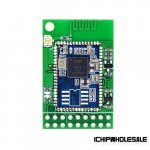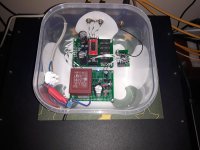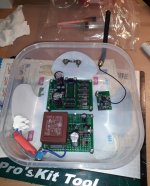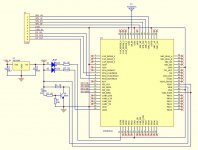You can use miro psu for +5V (you need two), but make sure you use big heatsink for xmos rail, it draws 500ma. And 8V on transformer, i wouldn't go lower for that drop.
As for opamp supply, it depends what kind of opamp you use. There is no universal rule for that. From what i see on the market, most discretes will have least distorsions at 15v, but it's neglible if you feed them 12v, so don't stress over it. Read specs of the one you want to utilize, and fashion the supply by it.
As for opamp supply, it depends what kind of opamp you use. There is no universal rule for that. From what i see on the market, most discretes will have least distorsions at 15v, but it's neglible if you feed them 12v, so don't stress over it. Read specs of the one you want to utilize, and fashion the supply by it.
There is no place for another psu-1 or 2. I need something small.You can use miro psu for +5V (you need two), but make sure you use big heatsink for xmos rail, it draws 500ma. And 8V on transformer, i wouldn't go lower for that drop.
As for opamp supply, it depends what kind of opamp you use. There is no universal rule for that. From what i see on the market, most discretes will have least distorsions at 15v, but it's neglible if you feed them 12v, so don't stress over it. Read specs of the one you want to utilize, and fashion the supply by it.
Yes, opamps feeds 12V for VA. I use LM6171.
@miro1360
I would like to propose a simpler board.
Since the shift register ICs are moved out of the board , there is no need for +-5v to exist on the boards at all.
We could just eliminate it. and use the real estate on the supply board to make a more complex power supply like the Walt jung regulator , which based on the tests provides much better sound.
Although the +/-5v is currently used to power the +/-VL , According to the spec sheet it could be any voltage between +/-5v and +/-12v provided the voltage used for +/-VL is lower than +/-VS. so just using a cap multiplier (or RC filter) to drop the voltage from 12v by about 2 volts would do the trick.
I can help with updating the board design if you are okay to share the source files.
Thanks
Mallik
I would like to propose a simpler board.
Since the shift register ICs are moved out of the board , there is no need for +-5v to exist on the boards at all.
We could just eliminate it. and use the real estate on the supply board to make a more complex power supply like the Walt jung regulator , which based on the tests provides much better sound.
Although the +/-5v is currently used to power the +/-VL , According to the spec sheet it could be any voltage between +/-5v and +/-12v provided the voltage used for +/-VL is lower than +/-VS. so just using a cap multiplier (or RC filter) to drop the voltage from 12v by about 2 volts would do the trick.
I can help with updating the board design if you are okay to share the source files.
Thanks
Mallik
@mallikreddyk Of course you can share everything 🙂 It is nice when someone create and share new things 😊
So why does the I2S over USB not need to use the shift registers? What other I2S input devices could do something similar?
It has a processor and the ability to use various jumpers to select the output signal in the appropriate format for various DAC chips, old and new. I don't know of another device with such capabilities.
The i2s to Pcm from iancanada does it with jumpers as well but needs a usb to i2s device before.
So if not a processor, classic shift registers are needed. Miro has the two pcb designs for the ad1862.
RTFT button: on 🙂
So if not a processor, classic shift registers are needed. Miro has the two pcb designs for the ad1862.
RTFT button: on 🙂
Shift registers are cheap, and then the choice of input interface is large, USB, SPDIF, TOSLINK, Bluettoth ... to I2S
Let's say this is my cheap experiment, one BT 5.0 module with I2S output and a Pavouk AD1865 DAC. It can also be used with any Miro DAC, all the same. The sound is very decent when using FLAC files, a little less decent with Youtube, Internet radio and the like. It's a pity that BT5.0 does not have lossless transmission.
Let's say this is my cheap experiment, one BT 5.0 module with I2S output and a Pavouk AD1865 DAC. It can also be used with any Miro DAC, all the same. The sound is very decent when using FLAC files, a little less decent with Youtube, Internet radio and the like. It's a pity that BT5.0 does not have lossless transmission.
Attachments
Last edited:
Shift registers (or glue logic) can easily cause ground bounce. Using USB-to-I2S/PCM board should be less noisy.
... active dsp may introduce different ptoblems, it is a trade off by design, however the JLSounds layout is very clean... 🙂
Fpga chip if you prefer the exact name, chip to call it short. DSP is easier to understand for everyone here.
Not necessarily FPGA. XMOS is not and neither is STM32F7 which I use myself. USB-to-I2S and USB-to-PCM does not involve any DSP or anything similar to glue logic.
ok... you perfectly understood what I meant, do not play on words, it is useless here for what I illustrated, if you used and tweaked all that gears as I did for 25 years you should understand!
Actually I don't understand what you mean. Can you give an example of "a different problem" that e.g. XMOS or STM32F7 introduces compared to shift registers? I2S that feeds the shift registers is in most cases generated by these same devices. Generating either I2S or directly PCM is just a change in software and that change in software does not cause any ground bounce.
That is crucial + recklocking with already present 4x.xxx MHz MCKs + attenuation of digital input signals before the DAC in the range from specs.But BB put a digital isolator between the filter and the PCM1702, we need to think about that.
.
Somehow for 300 pages is missing that the JL sounds does have digital ISO, BUT only from XMOS module to CPLD module.
I have done both USB-to-I2S/PCM board layout and software on STM32F7. I have also measured AD1862 dac with shift registers compared to direct PCM.@bohrok2610. Do your layouts with both and their supplies and see yourself please!
https://www.diyaudio.com/community/threads/uac2-0-on-stm32.393081/post-7208383
Last edited:
- Home
- Source & Line
- Digital Line Level
- DAC AD1862: Almost THT, I2S input, NOS, R-2R




